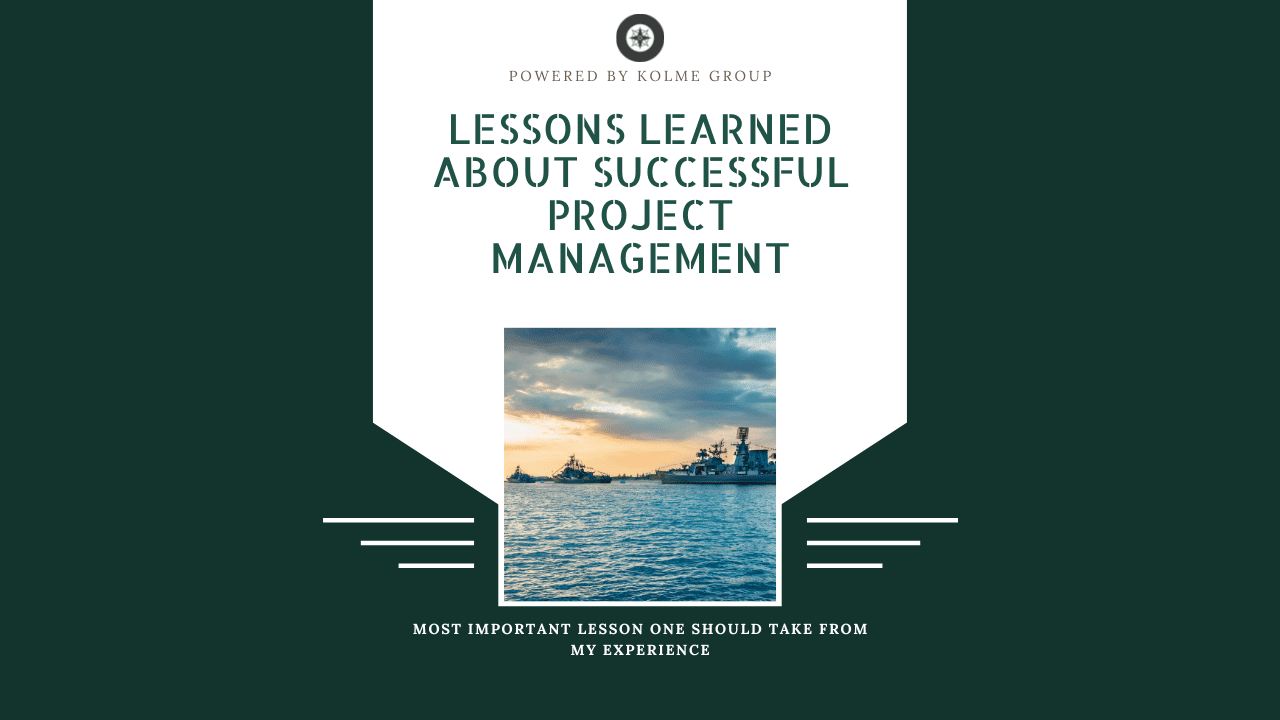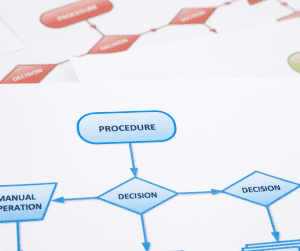Executive Summary
When I first joined the Navy, I never thought I would work as a project manager. Reflecting on my journey to becoming a project manager on the civilian side of things, I learned some valuable lessons. The knowledge and understanding needed to start a project, communicate, and bring valuable ideas to the team or teach others how to manage project plans come with unique and different skills required to be efficient and the best possible PM.
- Lesson #1: The Road to Success is Paved with Failure
- Lesson #2: Listening Is an Effect, Communication Is Cause
- Lesson #3: Define Roles Early on to Preserve Valuable Insights
- Lesson #4: Experience Is a Master Teacher
- Most Important Lesson One Should Take from My Experience
Lessons Learned About Successful Project Management
When first joining the Navy, it had never once crossed my mind that I would be working as a project manager. But that is what exactly happened, and I found myself improving processes that kept our aircraft carrier ready and available for use.
It All Started When…
My mentor brought me onboard an assignment to relocate a work center on time and within budget. Though difficult on the logistical side, this task made me realize what I wanted to focus on for the future. I wanted to start leading and mentoring future project initiatives and maybe even to teach classes to certify other people interested in process improvement.
I went out of the way to accept assignments that offered challenges and gave me more responsibility along the way. I began hopping on every project I could and even created some of my own.
One of my favorite yet most challenging initiatives was the maintenance process of an aircraft repaired on our naval base. The traction on this initiative picked up. Eventually, we had stakeholders at the Pentagon who were requesting status updates.
Lesson #1: The Road to Success is Paved with Failure
I always ensured that my unit had the resources to run the project from beginning to end with little to no hiccups. Planning and managing these efforts allowed me to gain more experience and knowledge performing my duties during active duty.
I quickly learned that it was an exciting position for someone with my rank. I had commanding officers from different bases who reported to my team. It was great; I experienced so much career growth in my role but also found that, like all jobs, there were some recurring issues I had to confront.
As I began to grow and gain experience as a project manager, the issues and roadblocks would become much more noticeable. Having so many military ranks supporting a project initiative made it challenging to have everyone’s ideas heard and considered.
Those of a lower rank helping would often get talked over, making it challenging to facilitate discussions. It took a project failure or two to finally find a solution to overcome this barrier my teams faced repeatable.
Lesson #2: Listening Is an Effect, Communication Is Cause
Two Things to Keep in mind when beginning:
- Begin With Introductions: I would start with introductions since a team generally is comprised of individuals with diverse backgrounds from all over.
- One Rule Motto: Next, I tell everyone that I have only one rule. To ensure ideas, whether good or bad, are heard, everyone needs to set their rank aside and work together to hear everyone equally. This expectation of collaboration helped tremendously, and even if it did not, I would pull someone in and ask their opinion of the vision and thoughts on it.
The challenges I experienced as a new project manager in the military have stuck with me. I could apply the lessons I learned to every project I managed, military or private. These lessons learned were the keys to my success.
Once I got my bearings as a project manager, I was able to run teams more efficiently and with little to no internal issues. It was beautiful being able to see everyone working together and getting along.
Lesson #3: Define Roles Early on to Preserve Valuable Insights
Often, stakeholders would request a meeting to discuss preliminary findings during a process assessment. Our team would gather all our data to show the inefficiencies and areas where we could improve. Solutions offered, of course, happened before discovering our best solution and implementing it.
The team would present to stakeholders and ask their thoughts/feedback on an internal or external issue. The feedback was insightful. However, the problem that we would run into occasionally was that the key stakeholders, who were typically the people in charge of our base, would tell us what to implement as a solution as soon as we presented the problem to them.
Yes, sometimes it was the only viable option, and the solution offered was an initiative we were looking at as a team. However, as an independent objective team, we weren’t even allowed to look into possible other solutions.
These decisions based on seniority would cause friction between the team and the stakeholders since they would either go ahead and implement their decisions on their own, causing the process improvement initiative to be scrapped, or forcing our team to implement this solution.
Of course, without proper Root Cause Analysis, you miss many valuable ideas that could have led to solutions. It takes time to perform a gap analysis of the process and adequately analyze this data collected.
Without working through the “Improve Phase” with the team, we did not have the proper knowledge to develop well-planned and effective controls in preventing the process from falling out of control after implementation.
Finding a way to resolve this significant barrier was time-consuming and very difficult. The resolution had to consider stakeholders were in a six-to-twelve-month rotation also. Talk about a complex puzzle to solve!
I realized I had to put in the hard work, and I started building a Standard Operating Procedure (SOP) for our project management office. This high-level document outlined the work breakdown structure and which roles had a final go-no-go approval since all projects differed slightly.
I spent a good two to three months developing this procedural document with the project management office (PMO). Finally, I sent it up the chain of command to get the document approved by our base commander, which it did.
This new SOP document now outlines that the team must run through the solution/implementation and control phases before implementing any solutions. It prevented any solutions from being implemented preemptively by the stakeholders.
Lesson #4: Experience Is a Master Teacher
Once I became more experienced in my role, I knew I wanted to teach others to be PMs. It was something I had always wanted to do as I worked my way up the PMO as a project manager. I was looking forward to refining all the skills I acquired working in the field, and teaching was definitely out of my comfort zone,
I first started by reworking the curriculum based on what I have learned and experienced as a project manager. Most of the time, while teaching project management skills, I was relating everything to experiences that I had personally. Incorporating in-field experience allowed me to show everyone who didn’t have prior knowledge of project management how it fits into their day-to-day work, even if they aren’t running a project.
I would also have students join my project team to teach and work on their instructor skills for more straightforward lessons. This approach was always a great mood lifter since it changes the pace in the classroom and draws a little more attention back to our learning objectives after being in class for four to six hours already.
My favorite part of teaching a project management class is at the end after everyone takes their exams, and I get to pass out their certifications! To see my students succeed in something they love and will pursue as a life long career, is a great honor.
I have received and am grateful for all the words of encouragement and the thanks my students gave me. It was a joy to hear that they appreciated how I taught and were inspired to pursue additional certifications.
Most Important Lesson One Should Take from My Experience
I am still amazed at how much I accomplished in the four years in my project manager role for the Navy armed forces. I got the chance to manage large-scale projects and manage others, even if they were my seniors. My duties also allowed me to meet, work, and teach with hundreds of people before becoming a civilian.
I still, to this day, get phone calls, text messages, and emails from former service members looking to learn more or asking for advice on the projects they are now running on their own. I get excited to see where all my mentees, students, and team members end up down the road and all the projects they lead that make incredible impacts.
My most asked question is, “How to handle difficult stakeholders during a project?” I typically tell them to set up a time with the stakeholder to hold a meeting and explain the team’s process and why it is so detrimental to the success of a project plans to circumvent the process, clarifying everything I worked hard to accomplish. Communicating steps taken allows your stakeholder to consider the significant impact his interference or judgment may have and hadn’t thought of initially.
Managing stakeholders was my most important and documented lesson learned and the most difficult to oversee as a PM. The whole reason behind an SOP process is to ensure that projects are analyzed, data is collected, and multiple corrective actions are developed and analyzed for the best solution to the problem.
Conclusion
When you consider what makes a successful PM, there are many aspects to consider. The knowledge and understanding needed to start a project, communicate, and bring valuable ideas to the team or teach others how to manage project plans come with unique and different skills required to be efficient and the best possible PM.
For some people, it may take months to become confident with these skills, and for others, it could take years. If you are willing to put in the time and effort to grow in areas you fall short of, you will certainly be going a step in the right direction as a PM. Feel free to reach out to me on LinkedIn if you have any questions and don’t forget to check out our careers page to learn if Kolme Group is a great fit for you!




